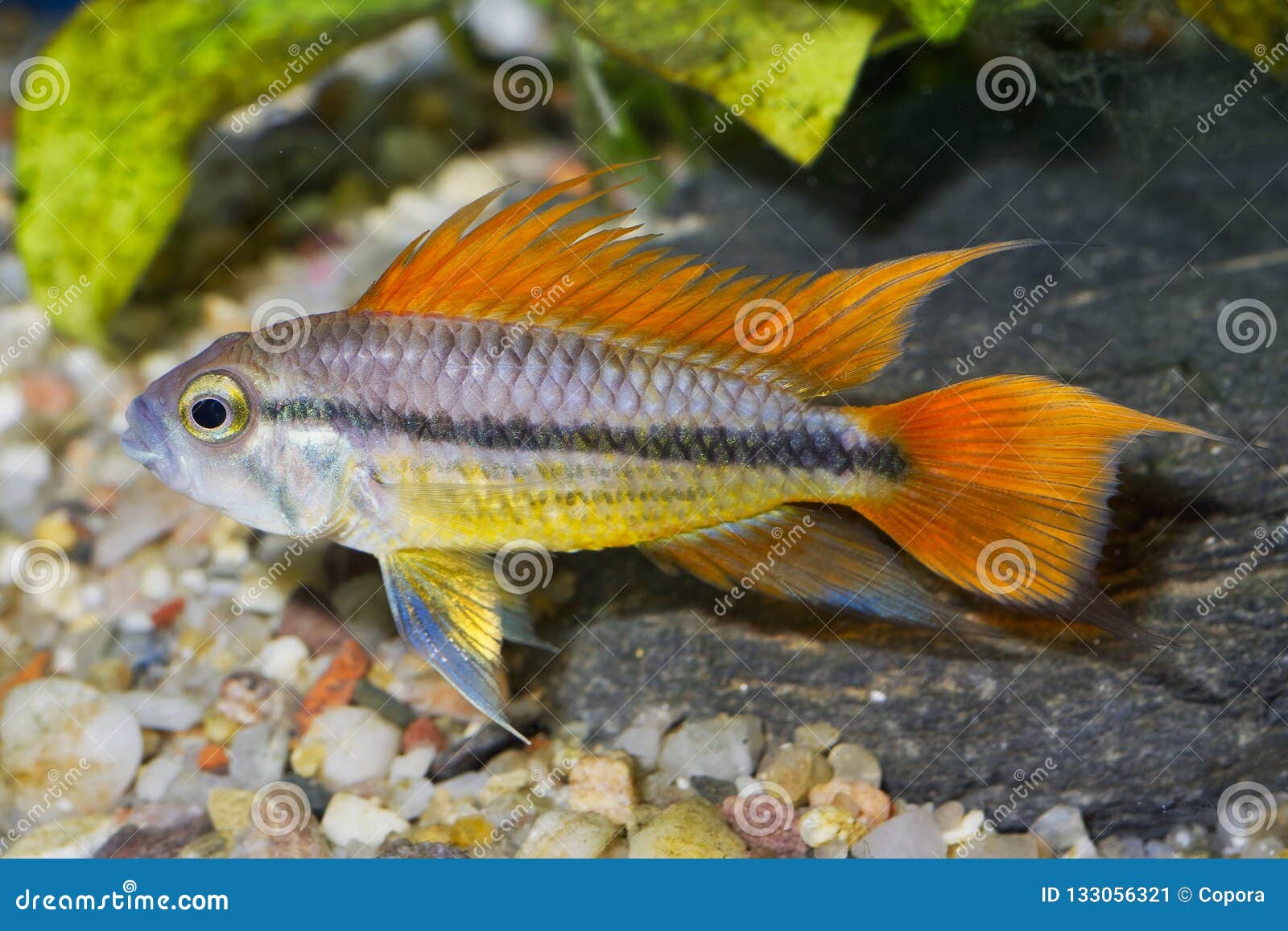


Some of the triple red couples can produce 3 different color variations. Some of the specifically bred out colorings are called Sunset, Red, Double Red, Triple Red, and Sun Spot. Though the wild caught fish are less dramatic, with today's selective breeding a variety of pretty color forms are readily available. Once she lays her eggs, her yellow coloring becomes more intense. Her tail fin will be more rounded as well. The male's belly and bottom fins are golden brown. Females will be a drab yellow with the front of the ventral fins becoming solid black as she matures. The top and bottom rays of the tail fin are longer as well, and brightly colored on the male. The male's first several rays of the dorsal fin are extended higher than the rest, giving the "cockatoo" look. The body has a silvery gray base and a long black horizontal line that runs through the middle. The males are larger, growing up to 4 inches (10 cm) in length while females only reach about 2 inches (5 cm). The Cockatoo Cichlid is a small colorful fish. IUCN Red List: NE - Not Evaluated or not listed.Scientific Name: Apistogramma cacatuoides.These cichlids are polygamous and form harems of a dominant male and multiple females. Both the litter and time of year can affect the type of water. These include tributaries, backwaters and creeks that are often strewn with leaf litter, apparently feeding mostly on benthic invertebrates. They prefer to dwell in shallow, slow-moving to almost still, clear and white water areas of the Amazon River. So in in the early 1960's they were sold to the hobby under that name. Meinken, in 1961, as the Umbrella Cichlid or Borelli's Cichlid Apistogramma borellii. Various natural color morphs can be found. Other common names they are known by are Cockatoo Dwarf Cichlid and Crested Dwarf Cichlid. This species is not listed on the IUCN Red List. In addition, they can be found in tributaries of the Solimoes, Ucayali, and Amazon rivers from the Pacheta River to Tabatinga. They are primarily found in Brazil and Bolivia inhabiting tributaries of the Amazon River basin. The Cockatoo Cichlid Apistogramma cacatuoides was described by Hoedeman in 1951. Coldwater Fish - Looking for cold water fish? (65 °).Similar size fish - Fish that are 1 inch bigger or smaller.Community Fish - Peaceful Freshwater fish.Beginner Fish - Freshwater fish for beginners.For Information on keeping freshwater fish, see:įreshwater Aquarium Guide: Aquarium Setup and Care Breeding a wild caught with a captive bred helps to keep the lines healthier. This defect should be watched for and all such fish humanely destroyed. This interbreeding for color has contributed to spinal malformations in the Cockatoo Cichlid. Though the wild caught fish are less dramatic, with today's selective breeding a variety of attractive color forms are readily available. Just a little dedication will reap pleasurable results from this little fish. If water quality is ignored, as with all cichlids, disease and death can occur. They can be easy to care for if water changes are performed frequently. Make areas for them to "defend" by having natural divisions in the aquascaping. They do enjoy densely planted aquariums and floating plants will help to diffuse the lighting. Provide a substrate of fine dark sand along with rocks and pots to create plenty of caves, one for each female's territory. Fish that are not large and aggressive will make the best tank mates. The Cockatoo Cichlid is considered a community fish that can be kept with other non cichlids. They are also easy to breed when their tank parameters are met. Their eggs will not hatch at that pH level, but the Cockatoo Cichlids themselves can be happy and thrive.

They do not have the acidic water needs of other dwarfs and can be kept in up to a 7.8 pH. These fish are some of the easier dwarf cichlids to keep. These common names are derived from the male having its first several rays of the dorsal fin extending higher than the rest, giving it a 'cockatoo' or 'crested' look. It is also known as the Cockatoo Dwarf Cichlid or Crested Dwarf Cichlid. The Cockatoo Cichlid Apistogramma cacatuoides is one of the most colorful of all the dwarf cichlids.


 0 kommentar(er)
0 kommentar(er)
